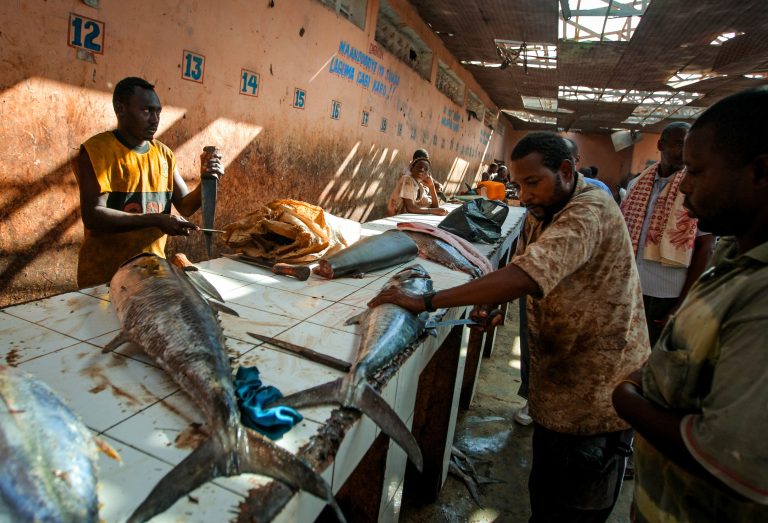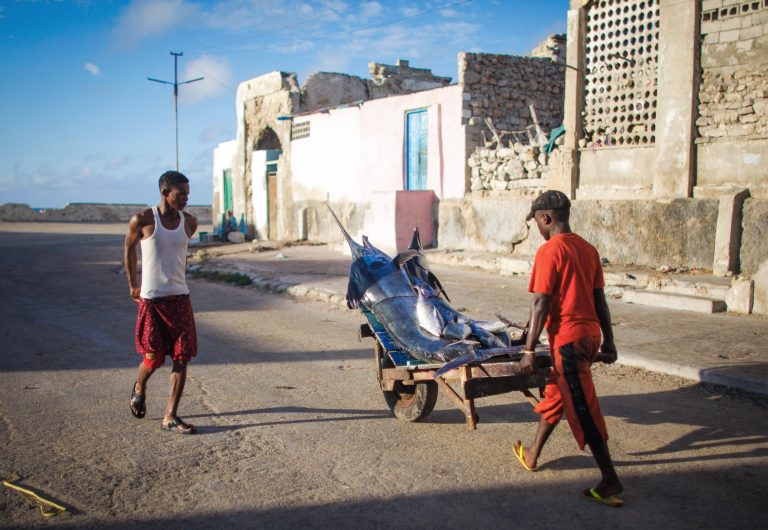Blog
Unlocking Somalia’s Untapped Blue Economy
How strategic investment, infrastructure upgrades, and sustainable practices could transformSomalia’s fisheries sector into a pillar of economic growth, job creation, and food security.

Traders cut and fillet fish inside Mogadishu’s fish market in the Xamar Weyne district of the Somali capital.
AU-UN IST/ Stuart Price
Somalia’s 3,333-kilometer coastline—one of the longest in Africa—is a sleeping economic giant. Despite this geographical blessing, the fisheries sector contributes only 3% to the country’s GDP and just 2% to total exports, according to World Bank figures.
However, new research by Somali Development and Reconstruction Bank (SDRB) suggests that, if sustainably developed, this sector could become a cornerstone of the country’s economic transformation, offering jobs, food security and export revenues.
Historically, Somalia’s fisheries sector has faced chronic underdevelopment. Even before the civil war of the 1990s, fishing contributed only about 1% to GDP. The war destroyed infrastructure and disrupted livelihoods. And while the sector has shown signs of revival in recent years, recovery remains inconsistent and uneven across regions.
Between 2017-2022, fish exports surged from $9.9 million to $51.3 million amounting to about a 400% increase. Meanwhile, estimates indicate that Somalia’s Exclusive Economic Zone (EEZ) could sustainably produce up to 500,000 metric tons of fish annually—far more than current yields.
The fisheries sector supports an estimated 90,000 full and part time workers, with an additional half a million people involved across the value chain. In a country with limited employment opportunities, especially in coastal and remote areas, fishing provides a vital economic lifeline.
Somalia’s coastline supports a variety of regionally specialized fisheries that contribute significantly to local economies and food security. In the south, Kismayo is particularly renowned for its rich lobster stocks and valuable demersal species such as Cod.
Mogadishu, the capital, serves as a central hub for the supply of fresh fish and facilitates inland distribution across the country. To the north, Eil and Bargal are prominent artisanal fishing centers, especially active in harvesting reef and pelagic species such as tuna. Meanwhile, Las Qorey and Berbera function as critical landing sites with strategic roles in regional trade, linking local fisheries to broader markets.
Somalia’s fishing industry, though rich in potential, is severely hampered by critical infrastructure gaps that undermine efficiency and profitability throughout the value chain. Post-harvest losses of 30-40% are common due to the lack of adequate cold storage, while poor roads and outdated ports inflate transportation costs by an additional 15-30%.
Compounding these challenges are the use of obsolete equipment and the absence of local fish processing facilities, which force most catches to be sold whole, limiting value addition. Furthermore, the unreliable electricity supply at landing sites impedes both storage and processing operations. These infrastructure deficits create costly bottlenecks from the moment fish are caught to when they reach consumers, stifling the sector’s ability to grow and compete.

A fisherman transports his day’s catch to Xamar Weyne’s fish market where it is sold for consumption.
AU-UN IST/ Stuart Price
Access to finance remains a major obstacle. Small-scale fishers lack collateral and credit history, while larger infrastructure projects require $50-70 million in investment. Traditional banking models struggle with the irregular cash flows typical of fishing operations and require specialized financial products.
The regulatory environment is equally challenging. Licensing is fragmented across multiple agencies, enforcement of fishing regulations is weak, and illegal, unreported, and unregulated (IUU) fishing costs Somalia an estimated $306 million annually. Furthermore, limited international certifications such as HACCP or ISO restricts Somalia’s ability to compete in high-value export markets.
According to 2020 World Bank figures, Somalia’s fish consumption remains among the lowest in the world at 2.4–3.3 kg per capita, compared to the global average of 19 kg. Cultural preferences for meat and limited inland distribution contribute to this. However, cities like Mogadishu are seeing rising demand, estimated at over 9 tons per day. With consumer education and better logistics, the domestic market offers considerable growth potential.
Investment and sustainability must go hand in hand to unlock the full potential of Somalia’s fisheries sector. Strategic investments such as expansion in cold storage to reduce spoilage and improve export quality can significantly increase productivity, raise export prices, and create much-needed jobs.
However, this growth must be managed carefully to avoid depleting vulnerable species like sharks and lobsters. Research calls for sustainable practices, including seasonal closures, catch limits, protection of breeding areas, eco-friendly gear, marine protected areas and community-led management.
Internationally, Somalia is already exporting to Gulf countries and has opportunities to expand into East Asia, the European Union, and East African regional markets. These measures not only ensure long-term viability but could also help Somalia obtain eco-certifications, unlocking access to premium international markets, and reinforcing a virtuous cycle of sustainable economic development.
“SDRB is currently finalizing its Fisheries Sector Strategy, a bold initiative that will see high level investments over the next three years to unlock the sector’s potential,” said Fahiima Mohamed, a Senior Analyst with SDRB. “By supporting improved processing, storage, and transport systems, SDRB-financed interventions could reduce post-harvest losses by up to 40%, significantly enhancing fish quality, increasing market value, and boosting incomes across the value chain,” she added.
Beyond financing, SDRB will play a catalytic role in facilitating public-private partnerships (PPPs) to upgrade critical infrastructure and promote regulatory compliance. These efforts will help align Somali fisheries with international standards, laying the foundation for sustainable fishing practices and expanding access to lucrative regional and global markets.
Somalia’s fisheries sector is at a crossroads. With the right blend of investment, infrastructure, regulation and sustainability, it could become a driver of inclusive economic growth. The sector’s revitalization would not only boost the nation’s GDP and exports but also enhance food security and livelihoods in some of the country’s most underserved regions.

